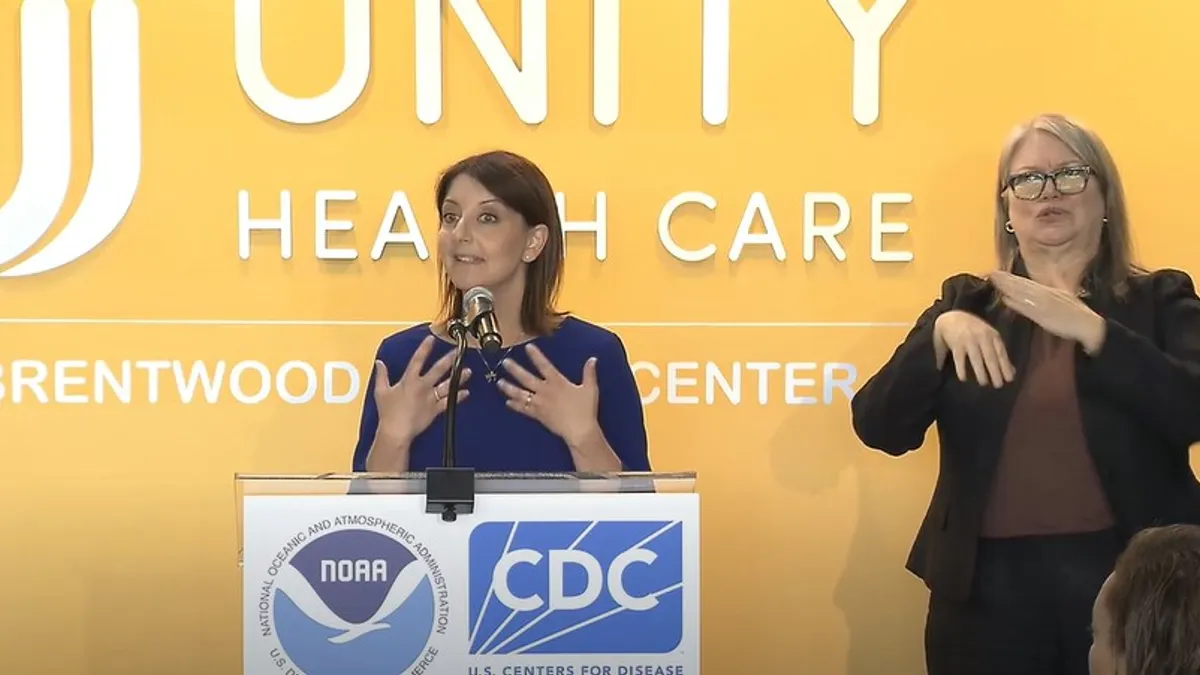Dive Brief:
- Communities nationwide now have access to an experimental online tool that forecasts how heat on a given day poses a risk to public health, the National Oceanic and Atmospheric Administration and Centers for Disease Control and Prevention announced this week.
- Available since 2017 in the Western U.S., the expanded HeatRisk tool is unique from other federal tools because it accounts for how unusual heat is in a specific location and pulls in CDC data on how that impacts public health. “90 degrees in Miami is not the same as 90 degrees in Portland, Maine,” said CDC Director Mandy Cohen at a Monday press conference.
- State and local decisionmakers can use HeatRisk’s seven-day forecast to understand when they should ramp up efforts to protect people from extreme heat, federal officials said at the press conference. A local transportation department might even choose to postpone outdoor work to a later date when heat risk is very high, said National Weather Service Director Ken Graham.
Dive Insight:
After last summer’s record-breaking heat, the National Weather Service predicts this summer will bring hotter-than-normal temperatures to almost every region in the U.S. In the face of climate change and a growing awareness of how dangerous extreme heat is to the human body, government officials are looking at ways to protect their communities.
A handful of local governments have hired chief heat officers to coordinate this work between departments, and some have recently developed heat action plans that outline both short and long-term strategies agencies will take to reduce the prevalence of heat-related illness in their communities.
Before expanding HeatRisk nationwide, the NWS provided other tools to help communities assess how high temperatures might impact them. The weather agency’s heat index measures how hot it feels when accounting for humidity, which makes warm temperatures feel more oppressive. The wet-bulb globe temperature provided by the agency factors in wind speed, the sun’s angle and cloud cover on top of humidity and air temperature. This metric for heat stress is often used to establish guidelines for modifying strenuous outdoor activities on hot days.
But these tools have their limits, NOAA says. The heat index doesn’t consider the impacts of hot nights, nor the health impacts of heat over an entire 24-hour period. Wet-bulb globe temperature isn’t as useful to understand the heat risk for sensitive populations, like children and older adults, whose thresholds may be much lower, or for people who are homebound without effective cooling. Wet-bulb globe temperature is also difficult to accurately predict beyond the next day or two.
What distinguishes HeatRisk? The tool considers how unusual heat is for the time of year, the duration of heat and if those temperatures pose an elevated risk of heat-related impacts based on CDC data. That allows the tool to better account for how acclimated people in a community may be to high temperatures, NOAA says.
“We see … in communities across the country different relationships between a specific temperature and what we see showing up in the emergency department,” said Dr. Aaron Bernstein, director of the National Center for Environmental Health and the Agency for Toxic Substances and Disease Registry, at Monday’s press conference.
HeatRisk uses five colors to indicate different levels of risk and who it might impact, and it provides information on what actions could be taken at each level for those at risk. The scale ranges from green, which means the expected heat poses little to no risk, to magenta, which indicates heat that affects anyone without adequate cooling or hydration.
Two separate dashboards exist for HeatRisk. The dashboard on NWS’s website is designed for public health audiences, like state and local officials. The CDC’s dashboard is designed for the general public and pulls in federal air quality data.
Federal officials underscored at Monday’s press conference that the tool is still experimental. The NWS is seeking feedback on HeatRisk, which can be submitted through this survey, and is planning a “massive training effort over the next few months across the country” for local officials, Graham said.
“Please use the tool,” Graham said. “Experiment with it. Get comfortable with it.”













